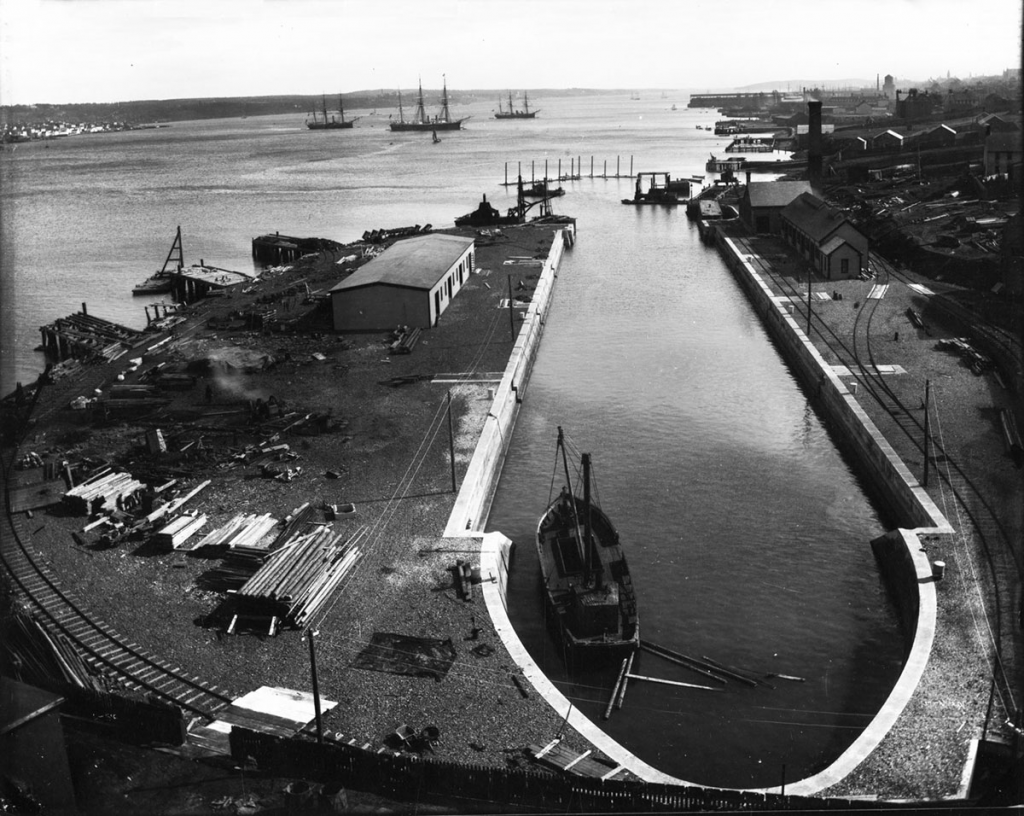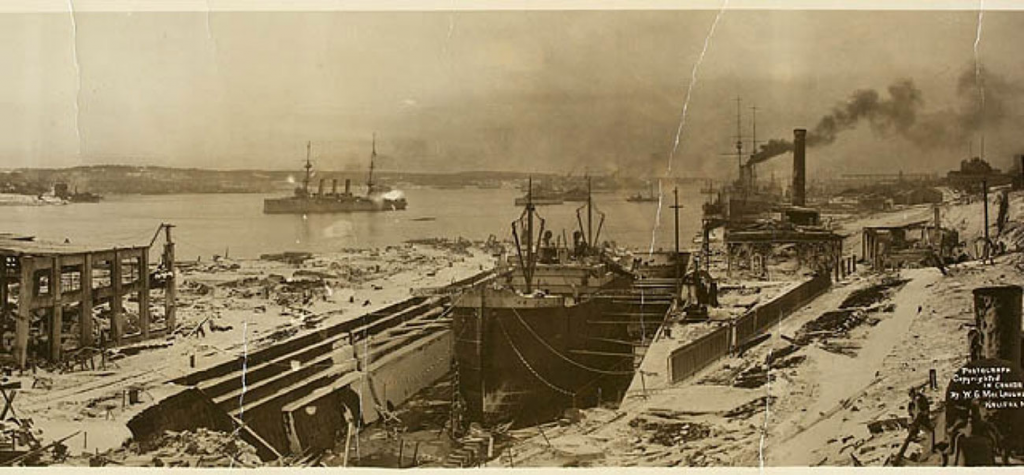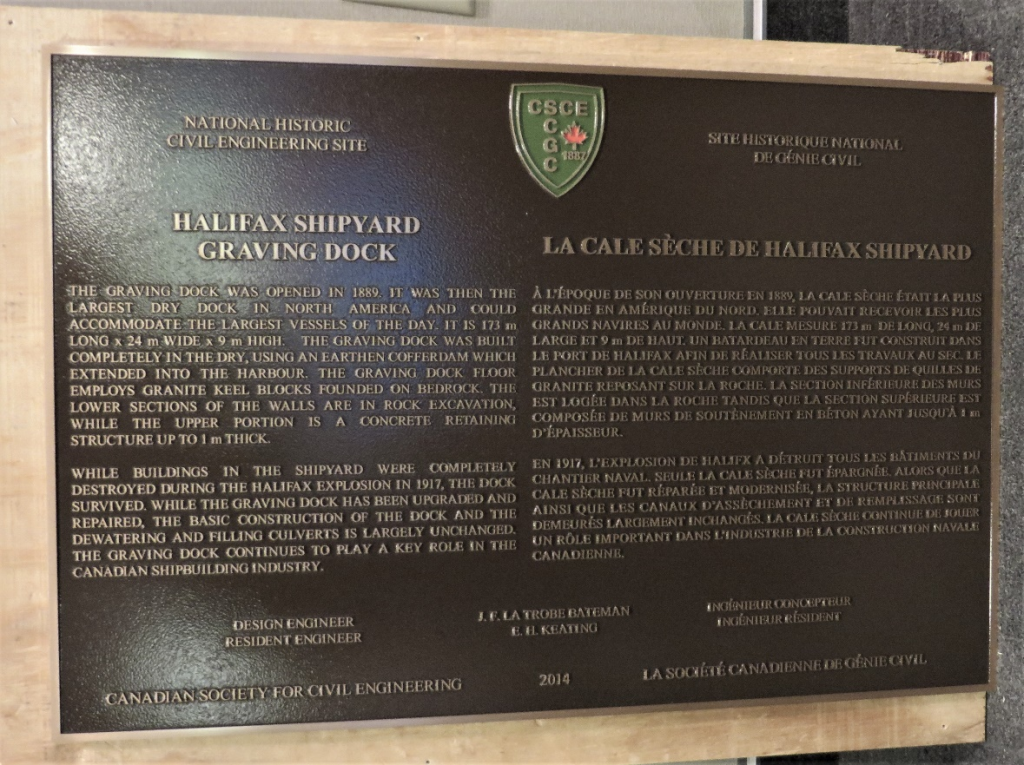Halifax Shipyard Graving Dock, Halifax, NS.


Site Location: Lat.: 44° – 39’ – 54” N.; Long.: 63° – 35’ – 34” W. (GPS: 44.665148, -63.592921). The graving dock is part of the Irving Shipyards facility in Halifax and inaccessible to the general public. It can be viewed from the west side of the Angus L. Macdonald Bridge, or from Barrington Street.
Plaque Location: The plaque is in the possession of Irving Shipyards facility in Halifax, and is currently inaccessible to the general public.

Description: The Halifax Graving Dock opened on September 21, 1889. The dock has a concrete lining of minimum thickness 0.9 m (3 ft.) and has square-cut ashlar stone for the entrance, steps in the wall, and tops of the retaining walls. The dock floor is 167 m (549 ft.) long, and the width increases from 21.3 m (70 ft.) at the floor to 31.1 m (102 ft.) at the top. At high tide, it can accommodate vessels with draughts up to 8.2 m (27 ft.). The basin holds 41 million l (9 million gal.) of water that the original pumps could remove in four hours.
The graving dock was owned by: Halifax Graving Dock Company from 1889 to 1918; Halifax Shipyards Limited, 1918 to 1978; Halifax Industries Limited from 1978 to 1985; Halifax-Dartmouth Industries Limited from 1985 to 1994, and Halifax Shipyard Limited, a wholly owned subsidiary of Irving Shipbuilding Inc., from 1994 to the present.


Historic Significance: The graving dock is over 130 years old and still performing, essentially according to original design. The original dock gate was in service for over a century. In 1917, the Halifax Explosion occurred 270 m (300 yds.) from the graving dock, and while the adjacent buildings were severely damaged, the graving dock survived.
Halifax has been a centre of shipbuilding since the Town of Halifax was established in 1749, but the roots of the current shipbuilding legacy began with the opening of the Halifax Graving Dock in 1889, in the heyday of wooden ships. Steel-hulled shipbuilding started in Halifax during World War I in 1918. During World War II, Halifax Shipyards Limited built the first all-Canadian destroyers, and an impressive number of vessels since. Several thousand ships have been repaired at the graving dock, notably those that were damaged during the Battle of the Atlantic.
Between 1918 and 1978, no other industry contributed more to the prosperity of Halifax and the province than shipbuilding. The Halifax Graving Dock remains a vital asset to support the national shipbuilding procurement program, projected to cost $25 billion over the next 30 years.

Plaque Wording: National Historic Civil Engineering Site. CSCE. HALIFAX SHIPYARD GRAVING DOCK. This graving dock was opened in 1889. It was then the largest dry dock in North America and could accommodate the largest vessels of the day. It is 173 m long x 24 m wide x 9 m high. The graving dock was built completely in the dry, using an earthen cofferdam which extended into the harbour. The graving dock floor employs granite keel blocks founded on bedrock. The lower section are in rock excavation, while the upper portion is a concrete retaining structure up to 1 m thick. While buildings in the shipyard were completely destroyed during the Halifax Explosion in 1917, the dock survived. While the graving dock has been upgraded and repaired, the basic construction of the dock and the dewatering and filling culverts is largely unchanged. The graving dock continues to play a key role in the Canadian shipbuilding industry. Design Engineer J. F. La Trobe Bateman. Resident Engineer E. H. Keating. Canadian Society for Civil Engineering. 2014.
SCGC. Site Historique de Génie Civil. À l’époque de son ouverture en 1889, la cale sèche était la plus grande en Amérique du Nort. Elle pouvait recevoir les plus grands navires au monde. La cale mesure 173 m de long, 24 m de large et 9 m de haut. Un batardeau en terre fut construit dans le port de Halifax afin de realiser tous les travaux au sec. Le plancher de la cale sèche comporte des supports de quills de granite reposant sur la roche. La section inférieure des murs et logée dans la roche tandis que la section supérieure est composée de murs de soutènement en béton ayant jusqu’à 1 m d’épaisseur. En 1917, l’explosion de Halifax a détruit tous des bâtiments du chantier naval. Seule la cale sèche fut épargnée. Alors que la cale sèche fut réparée et modernisée, la structure principale ansi que les canaux d’assèchement et de remplassage sont demeurés largement inchangés. La cale sèche continue de jouer un role important dans l’industrie de la construction navale canadienne. J. F. La Trobe Bateman Ingénieur concepteur. E. H. Keating Ingénieur resident. 2014. Société canadienne de genie civil.
Plaque Unveiling Ceremony: The plaque was unveiled in a tent at Irving Shipbuilding, overlooking the Halifax Graving Dock, on May 30, 2014.

Links to Online Documentation:
Halifax Military Heritage Preservation Society, “Halifax Graving Dock”
Dalhousie University Memory NS, “Halifax Graving Dock Company fonds”.
Tom Tulloch, “The Halifax Graving Dock and the 1917 Explosion”, Argonauta, 2019. (See page 6)